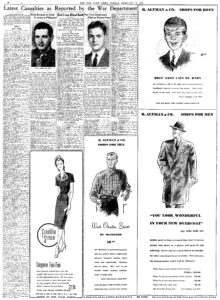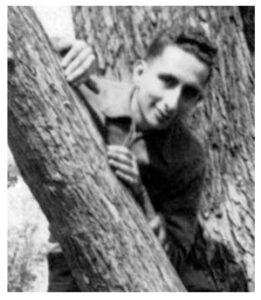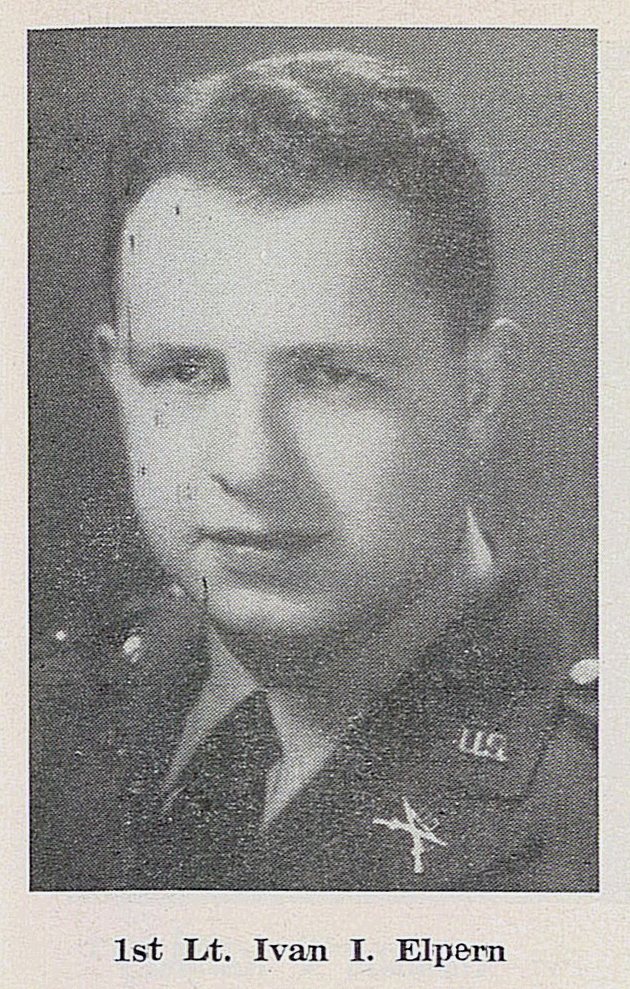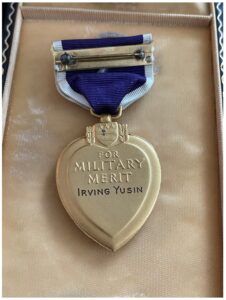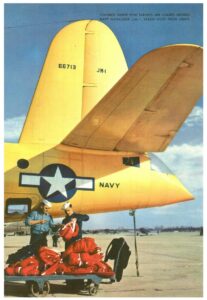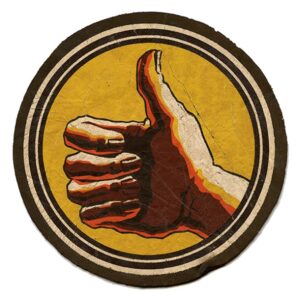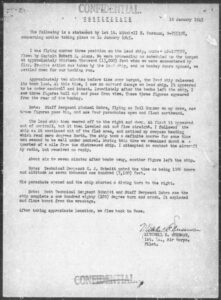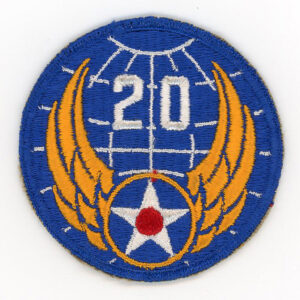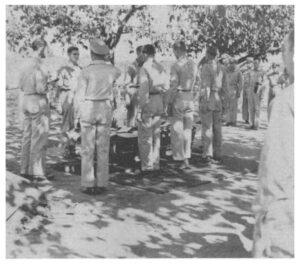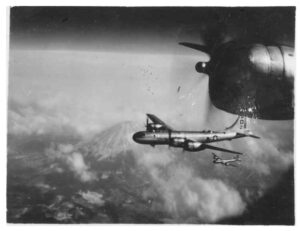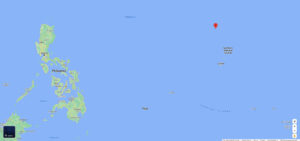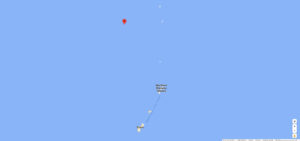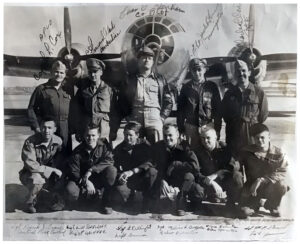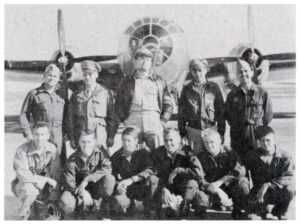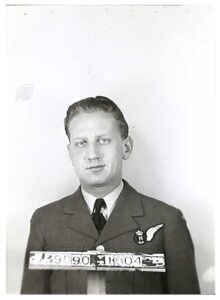My blog posts visit the past with an eye upon the present, and, this post is no different.
Created in May of 2017 (six years ago … was it that long?!) as part of my ongoing series about Jewish military service and Jewish military casualties in the Second World War, based on articles in The New York Times, it’s now up for a “rewrite”.
The impetus for this post is the Times’ news item of February 11, 1945, about Captain Arthur Henry Bijur of Long Branch, New Jersey. A member of the 43rd Signal Company of the 43rd Infantry Division, he was killed in action on January 14, 1945, near Rosario, Luzon, in the Philippines. Awarded the Purple Heart and Silver Star, his citation for the latter medal was published in the Times on August 22 of the same year, while news about his death in combat appeared in the Daily Record (of Long Branch) on February 13.
Born in Manhattan on February 14, 1919, Captain Bijur’s parents were Nathan Isaac (7/2/75-12/7/69) and Eugenie (Blum) Bijur (4/1/86-2/80); his brothers were Herbert and Lt. William Bijur; his sister was Mrs. Jean Weiss. The National World War Two Memorial Registry includes entries in his honor by Dr. John Wolf (his friend), and, classmate John Liebmann.
This portrait of Captain Bijur is via FindAGrave contributor and Vietnam veteran THR.
Captain Bijur is buried at the Manila American Cemetery, in the Philippines (Plot A, Row 9, Grave 104).
As you can read in the transcript of his obituary, Captain Bijur seems not to have had any direct residential or vocational connection to either Manhattan in particular or the New York Metropolitan area in general. As such, the impetus for the Times news coverage of his death may have been his association with Brown University, and, the Horace Mann School. Well…just an idea.
So, here’s the article of February 11…
Word Received of Death in Action in Philippines
Capt. Arthur Henry Bijur, who served in the Army Signal Corps, was killed in action on Luzon in the Philippines on Jan. 14, according to word from the War Department received Friday by his parents, Mr. and Mrs. Nathan I. Bijur of Long Branch, N.J. He would have been 26 years old on Feb. 14.
Born in New York City, Captain Bijur was an outstanding athlete at the Horace Mann School, winning four major letters. He later attended Brown University, where he was captain of the soccer team. He was graduated from the university in 1941 and enlisted in the Army shortly afterwards.
In March, 1942, he was appointed a second lieutenant and in August was shipped to the Pacific, where he took part in the Munda campaign, and the invasion of New Guinea and the Philippines. Captain Bijur was the recipient of two citations.
In addition to his parents, he is survived by two brothers, Herbert Bijur and Lieut. William Bijur; and a sister, Mrs. Joseph D. Weiss.
This image shows page 30 of The New York Times of February 11, 1945, with Captain Bijur’s obituary at the upper left, set within that day’s War Department (Army, only) Casualty List, which was limited to coverage of the New York Metropolitan area, northern New Jersey, and Connecticut.
____________________
And, here’s his award citation…
POSTHUMOUS AWARD
Silver Star for Captain Bijur of Army Signal Corps
The Silver Star Medal has been awarded posthumously to Capt. Arthur H. Bijur, 242 Bath Avenue, Long Branch, N.J., of the Army Signal Corps for gallantry in action against the Japanese on Luzon. He lost his life when he crawled out of his foxhole to warn his men that enemy fire would soon run through their area. He was killed by an enemy shell shortly after his last warning was given.
Captain Bijur’s citation praises his “keen devotion to duty, loyal consideration for his men and great courage.” He was overseas for thirty-four months with the Forty-Third Division and was in action at Guadalcanal, in the Northern Solomons, in New Guinea and on Luzon.
A memorial plaque honoring Captain Bijur – seen in this image by FindAGrave contributor RPark – can be found at Beth Olom Cemetery, in Ridgewood, Queens, New York.
____________________
Paralleling my other posts about Jewish servicemen who were the subject of news coverage by The New York Times, here’s biographical information about some (not all…) other Jewish servicemen who were casualties on the same January day in 1945. Actually, there’s such a massive amount of information available about the events of this day that another post will cover Jewish aviators in the Eighth Air Force, particularly focusing on the 390th Bomb Group, the entirety of one squadron of which was shot down during the Group’s mission to Derben, Germany.
________________________________________
For those who lost their lives on this date…
Sunday, January 14, 1945 / Tevet 29, 5705
– .ת.נ.צ.ב.ה. –
…Tehé Nafshó Tzrurá Bitzrór Haḥayím
May his soul be bound up in the bond of everlasting life.
________________________________________
United States Army
Killed in Action
Benenson, Irving, T/5, 32195917, Bronze Star Medal, Purple Heart, Casualty at Vielsalm, Belgium
3rd Armored Division, 32nd Armored Regiment
Casualty List 3/14/45
Born Brantville, Ma., 2/1/17
Mrs. Lillian Benenson (wife), 1659 President St., Brooklyn, N.Y.
Mr. and Mrs. Reuben / Ruben J. (2/1/87-1963) and Ray (4/14/90-7/68) Benenson [Witkoff] (parents)), 1767 Union St., Brooklyn, N.Y.
Oscar Benenson (brother)
Zachary Taylor National Cemetery, Louisville, Ky. – E, 268 (Collective grave with T/5 Dee E. Hobbs)
American Jews in World War II – 273
____________________
Chernoff, Alvin S., PFC, 32408380, Purple Heart; Casualty in Belgium (Died of wounds)
11th Armored Division, 55th Armored Infantry Battalion
Born New York, N.Y., 1/14/14
Mr. and Mrs. Herbert Louis (5/2/83-7/63) and Florence Rosalind (Danielovich) (4/15/95-9/28/35) Chernoff (parents), 115 W. 86th St., New York, N.Y.
Luxembourg American Cemetery, Luxembourg City, Luxembourg – Plot G, Row 11, Grave 19
Casualty List 3/12/45
American Jews in World War II – Not listed
This photo of PFC Chernoff is via FindAGrave contributor pjammetje.
____________________
Coslite, Milton G., S/Sgt., 31051962, Purple Heart
11th Armored Division, 55th Armored Infantry Battalion; Casualty in Belgium
Born New York, N.Y., 12/17/18
Mrs. Eva Ginsberg (mother), 2168 63rd St., Brooklyn, N.Y.
Luxembourg American Cemetery, Luxembourg City, Luxembourg – Plot C, Row 2, Grave 18
Casualty List 3/13/45
American Jews in World War II – 294
This photo of S/Sgt. Coslite is via FindAGrave contributor Andrew.
____________________
Elpern, Ivan Isadore, 1 Lt., 0-385676, Purple Heart; Casualty in Belgium
6th Armored Division, 50th Armored Infantry Battalion
Born Uniontown, Pa., 3/8/17
Mr. and Mrs. Lewis Herman (3/3/86-1/4/41) and Margaret (Goldstone) (4/2/93-6/20/64) Elpern (parents), 101 Central Square, Pittsburgh, Pa.
Melvin H. Elpern (brother); Marvin Fortman (cousin)
Enlisted 1935
The official Casualty List of the 6th Armored Division (NARA Records Group 407), and Lt. Elpern’s 293 File list his military organization as “6th Armored Division, 50th Armored Infantry Battalion”, but his matzeva displays organization as “28th Infantry Division, 110th Infantry Regiment – 2/17/41-7/19/42”
Temple Emanuel Cemetery, Greensburg, Pa. – Section B, Row 25, Lot 2; Buried 12/20/48
Jewish Criterion (Pittsburgh) 9/7/45
The Pittsburgh Press 12/19/48
American Jews in World War II – 518
Ivan’s Elpern’s portrait – below – was published in Pittsburgh’s Jewish Criterion on September 7, 1945, in an extremely detailed – and quite accurate – article commemorating Jewish servicemen from the Pittsburgh metropolitan area who were killed or died during the just-ended war. The article carries brief biographical profiles, and photographs, of 83 servicemen, and lists the names of 32 other servicemen for whom information and images – at the time of publication – were missing. In terms of individual attention, communal memory, and foresight, the Criterion’s effort was as admirable as it was remarkable, for not all Jewish periodicals published such retrospectives.
____________________
Haberer, Martin, Pvt., 32962210, Purple Heart
101st Airborne Division, 327th Glider Infantry Regiment
Born Heidelberg, Germany, 2/5/25
Mr. and Mrs. Max and Laura (Wertheimer) Haberer (parents), 3810 Broadway, Apt. 4-A, / 550 West 158th St., New York, N.Y.
Long Island National Cemetery, Farmingdale, N.Y. – Section J, Grave 15963
Casualty List 3/13/45
Aufbau 2/16/45
American Jews in World War II – 339
____________________
Levine, Alfred, Pvt., 39015817, Purple Heart
26th Infantry Division, 101st Infantry Regiment
Born Los Angeles, Ca., 9/3/16
Mr. and Mrs. Jacob (Zusmanovich) (11/15/80-5/1/71) and Ida S. (5/15/82-7/8/67) Levine (parents), 1427 Levonia Ave., Los Angeles, Ca.
Luxembourg American Cemetery, Luxembourg City, Luxembourg – Plot H, Row 5, Grave 12
Casualty List 3/1/45
American Jews in World War II – 48
____________________
Rindsberg, Walter Josef, Pvt., 42071539, Purple Heart
84th Infantry Division, 335th Infantry Regiment
Born Germany, 9/20/25
Mr. and Mrs. Harry (Heinreich) (6/22/87-8/39) and Irma (Himmelreich) (12/12/99-2/94) Rindsberg (parents), 44 Bennett Ave., New York, N.Y.
Henri-Chapelle American Cemetery, Henri-Chapelle, Belgium – Plot D, Row 7, Grave 8
Casualty List 3/8/45
Aufbau 2/2/45, 2/16/45
American Jews in World War II – 413
____________________
Yusin, Irving, Pvt., 13153939, Purple Heart
11th Armored Division, 21st Armored Infantry Battalion
Born New York, N.Y., 4/1/22
Mrs. Celia Yusin (mother), 2853 Barker Ave., New York, N.Y.
Wellwood Cemetery, East Farmingdale, N.Y.
Casualty List 3/14/45
American Jews in World War II – 476
This image of Private Yusin’s Purple Heart is via FindAGrave contributor John Mercurio.
____________________
On September 20, 1946, the Jewish Criterion published a moving and affecting article by Helen Kantzler entitled “Double Gold Stars”, which reported upon families of American Jewish soldiers who had lost two (and in one case, all three) sons in military service during the Second World War. Aside from the completion and existence of such a story so shortly after the war’s end, was Ms. Kanlster’s level of detail and accuracy, her story probably having been based on information acquired by the National Jewish Welfare Board, and, her own dogged research.
Among the numerous families discussed in her article was that of Max (1873-1/2/29) and Rose (Sankofsky) (1878-9/10/55) Zion, of 3738 East 139th St., in Cleveland, Ohio. Their sons, PFC Morris Jack Zion (35289875) and Aviation Radio Technician 1st Class Joseph Manuel Zion (6153983), both born in Cleveland, were lost within the space of the same January week in 1945. The family also included twin brothers Harry and Robert, and sisters Tillie, Mrs. Mildred Hershman, and Mrs. Sara (Zion) Oriti. Morris and Joseph were members of the approximately fifty American Jewish families who lost both sons during the Second World War. (The Liebfeld family of Milwaukee lost all three sons: Morris (USMC), Samuel (Army Air Force), and Sigmund (also Army Air Force), the latter on a domestic non-combat flight in October of 1945. The brothers are buried at Chesed Shel Emeth Cemetery, in Saint Paul.)
Along with Helen Kantzler’s Jewish Criterion article, the brothers’ names appeared in the Cleveland Press & Plain Dealer on February 2, and can be found on page 504 of American Jews in World War II.
PFC Zion, a member of the 330th Infantry Regiment, 83rd Infantry Division, was born in Cleveland on January 30, 1912. He died of wounds on January 14, 1945, at the age of 33. (Yes, 33.) He’s buried at Henri-Chapelle American Cemetery, at Henri-Chapelle, Belgium, at Plot D, Row 13, Grave 12.
This portrait of Morris is via FindAGrave contributor Patti Johnson, a Volunteer Researcher studying the WW II Army Air Force’s Mediterranean-based 57th Bomb Wing.
Joseph’s picture, displayed below, is also via Patti Johnson.
Born in Cleveland on August 15, 1908, Joseph Manuel was serving in the Navy when he hitched a ride on a JM-1 Marauder (the Navy and Marine Corps version of the Martin B-26 Marauder) of Naval Squadron VJ-16, the tow target and utility services for the Atlantic Fleet in the Florida and Caribbean areas, in January 1945 based at Miami. The bomber, Bureau Number 66724, piloted by Lt. Raymond Paul Mara, Jr. and carrying seven other crew and passengers, crashed at sea 15 miles west of San Juan, Puerto Rico, not long after take-off, from what was suggested to have been engine failure. However, the definitive cause of the bomber’s loss – given the absence of survivors, lack of recovered debris, and nature of 1940s technology – probably could never have been definitively established.
Here are two images of JMs, whose simple overall chrome yellow paint schemes lend them the appearance of winged bananas. It’s my understanding that all JMs were finished similarly, or at least those serving as target tugs.
These two image of JM-1 Marauders are from the flickriver photo collection of torinodave72.
While Joseph Manuel Zion has no grave, his name does appear in the Tablets of the Missing at the East Coast Memorial, in Manhattan.
____________________
Prisoners of War
Private Jack Bornkind (Yakov bar Nachum) (16150444), a member of 1st Battalion, B Company, 274th Infantry Regiment, 70th Infantry Division, was captured on January 14, 1945 and interned as a POW at Stalag 9B, in Bad Orb, Germany. He was one of the 350 American POWs sent from that POW camp to the Berga am Elster slave labor camp as part of Arbeitskommando [labor detail] 625.
The image below, scanned from a paper photocopy, shows the last of the 44 pages comprising the “master” list of the 350 POWs sent to Berga, with six names comprising the final entries. From top to bottom, this page carries the names of Pvt. Alexander Weisberg (survived), Pvt. David Goldin (also survived), PFC Morton D. Brimberg (survived as well; surname changed to “Brooks” partially due to postwar experiences with antisemitism in academia), followed by the names of PFC Stanley Rubenstein, Sgt. Seymour Millstone, and finally Jack Bornkind.
Data fields include the soldier’s German-assigned POW number, surname, first name, date of birth, parent’s surnames, residential address and name of “contact”, Army serial number, and place/date of capture. Ironically, neither the soldier’s religion nor ethnicity are present.
Private Bornkind himself was one of the 76 soldiers who died as a result of their imprisonment at Berga. Of this number, twenty-six men died from the appalling conditions at the camp (one of whom – Pvt. Morton Goldstein – was murdered by camp commander Erwin Metz on March 20, 1945, after an escape attempt), while the remaining fifty succumbed to the forced march of POWs away from the camp, which commenced on April 6. Of these fifty, Jack Bornkind died on the morning of April 23 in the company of a few fellow POWs (among whom was PFC Gerald M. Daub) literally minutes before the group was liberated by either the 11th Armored Division or 90th Infantry Division. Pvt. Bornkind was the very last fatality “of” Berga while the war was still ongoing. Private Aaron Teddy Rosenberg, who survived the ordeal and seemed to have returned to health, took ill not long after his return to the United States, and passed away in his home state of Florida on June 27, 1945, a little over two months after his liberation.
Born in Flint Michigan, on January 31, 1924, Jack Bornkind’s parents were Nathan N. (12/25/79-9/17/52) and Rachel (Handelsman) (1888-7/17/61) Bornkind of 731 East Dartmouth Road, Flint, Michigan, while his sisters and brothers were Bessie, Celia, Hildah, Josephine, Llecca, Louis, and Sarah. He was buried at Beth Olem Cemetery in Hamtramack (Section 3, Plot 344-5) on January 9, 1949, an event mentioned in the Detroit Jewish Chronicle on January 14 of that year. His name can be found on page 188 of American Jews in World War II.
Information about what befell the 350 men assigned to Arbetiskommando [labor detail] 625 is readily available, both in book format and, at numerous websites. (See the 2005 books Soldiers and Slaves : American POWs Trapped by the Nazis’ Final Gamble, by Roger Cohen and Michael Prichard, and, Given Up For Dead : American GIs in the Nazi Concentration Camp at Berga, by Flint Whitlock, and, Charles Guggenheim’s documentary, Berga: Soldiers of Another War.) What’s especially appalling about the story, aside from the brutal treatment of the POWs per se, was how bureaucratic apathy in combination with rapidly changing political alliances in the context of the (first) Cold War rapidly and directly affected, hindered, and ultimately negated efforts to secure justice for the POWs and their families.
The following two images of Jack Bornkind are from the Leibowitz Family Tree at Ancestry.com.
The academic setting of this colorized picture – looks like a college campus, doesn’t it? – together with Private Bornkind’s uniform, suggests that the picture was taken while he was serving in ROTC, or, assigned to the ASTP (Army Specialized Training Program).
This picture is a little more straightforward: In the Army, Private Bornkind is wearing the shoulder sleeve insignia of the Army Service Forces.
This image of Jack Bornkind’s matzeva is via FindAGrave contributor TraceyS.
____________________
Lippin, Robert, PFC, 32974463
26th Infantry Division, 328th Infantry Regiment
Stalag 12A (Limburg an der Lahn)
Born Boston, Ma., 6/7/23; Died 6/17/84
Mr. Bernard B. and Lillian (Scholl) Lippin (parents), Joseph (brother), 8020 Bay Parkway, Brooklyn, 14, N.Y.
NARA RG 242, 190/16/01/01, Entry 279, Box 41. # 96673
American Jews in World War II – Not listed
Though I don’t have a photographic portrait of Robert Lippin, this image of his German Personalkarte, from Records Group 242 in the United States National Archives, will suffice. Though Personalkarte forms include a specific “field” for a prisoner of war’s photograph on the sheet’s left center, the majority of such cards in RG 242 are absent of such images. I think this is reflective of the very large number of American POWs captured during the Ardennes Offensive, and the consequent challenge in “processing” – informationally, that is – such a large number of men. As I recall from examining the original document, the reverse was absent of any notations. Otherwise, I would’ve scanned it.
____________________
Wounded in Action
Alper, Eugene, Pvt., 37642240, Purple Heart; Wounded in Germany
Born St. Louis, Mo., 9/7/25; Died 2/19/17
Mr. and Mrs. Nathan (1/12/88-9/67) and Annie (Shoenfeld) (1880-2/58) Alper (parents), 738 Interdrive, University City, St. Louis, Mo.
Saint Louis Post Dispatch 2/21/45
American Jews in World War II – 207
Hershfield, Jesse Louis, PFC, 33810667, Purple Heart; Wounded in France
Born Albany, N.Y., 3/12/20; Died 4/26/09
Mrs. Lillian (Mantz) Hershfield (wife) Rachelle (daughter), / / 3320 W. Cumberland St. / Philadelphia, Pa.
Philadelphia addresses also 2323 North 33rd St. and 3345 Indian Queen Lane,
Mrs. Anna Hershfield (mother), 3112 Ridge Ave., Philadelphia, Pa.
NJWB card incorrectly gives surname as “Hershfeld”
The Jewish Exponent 2/23/45, 3/9/45
Philadelphia Inquirer 2/13/45
Philadelphia Record 2/13/45
American Jews in World War II – 528
____________________
Another Incident…
Schrag, Emil, PFC, 31336965, Medical Corps, Bronze Star Medal
30th Infantry Division, 120th Infantry Regiment
Born Baden, Germany, 11/9/24; Died 10/9/03
Mrs. Hilde Dorothee (Schrag) Heimann (sister), New York, N.Y.
Mr. and Mrs. Siegfried (5/19/82-?) and Lena Friedericks (Kahn) (7/27/97-6/74) Schrag (parents), 510 W. 184th St., Bridgeport, Ct.
Mr. Eugene Kahn (friend), 260 Maplewood Ave., Bridgeport, Ct.
Aufbau 2/9/45, 5/4/45
American Jews in World War II – Not Listed
According to Aufbau, Private Schrag was involved in some kind of incident in Germany on January 14, but the details are unknown. He returned to Military Control by April 12.
____________________
United States Army Air Force
Captain Sanford Saul Fineman
2115th Army Air Force Base Unit (Continental United States)
The loss of an RB-24E liberator (the “R” prefix indicating an aircraft utilized for aerial gunnery training) in Alabama on the evening of January 14, 1945, is representative of the near-daily loss of aircraft and airmen on missions – training and otherwise – that did not involve contact with the enemy.
Piloted by Captain Sanford Saul Fineman (Shmuel bar Yaacov Faynman; ASN 0-796353), the aircraft – assigned to the 2115th Army Air Force Base Unit – took off from Courtland Army Airfield, Courtland, Alabama, at 2100 on a routine night training mission. The aircraft, 42-7113, entered the traffic pattern and Captain Fineman radioed the tower for permission to make a touch-and-go landing. He was told to stay in the pattern because of numerous aircraft on end of runway waiting for takeoff, Captain Fineman acknowledging and going around. There were no further communications between the pilot and the tower, and a few moments later, the bomber stalled and crashed in a turn to the left, one mile east of Town Creek, Alabama. There were no survivors.
The Liberator’s other three crewmen were:
Co-Pilot: 2 Lt. William Walter “Billy” Miller, Jr.
Co-Pilot: 2 Lt. Theophil Charles Polakiewicz
Flight Engineer: Cpl. Irvin Earl Barrington
A veteran of service in the 66th Bomb Squadron of the 44th Bomb Group, Captain Fineman previously received the Distinguished Flying Cross, Air Medal, and five Oak Leaf Clusters. While serving in the 66th, he’s documented as having been a witness to the loss of B-24J 42-99996 (QK * I), piloted by 2 Lt. William M. Richardson (from which there were no survivors) during the 44th Bomb Group’s mission to Langenhagen Airdrome, Germany on April 8, 1944, during which the 44th Bomb Group lost eleven B-24s. The plane’s loss is covered by Missing Air Crew Report 3763, which, due to the chaotic and intense nature of the air battle, simply states, “…that aircraft #996 apparently was hit by enemy aircraft at 1345 hours in the vicinity of Salzwedel and was seen to go down. No chutes were observed. At least five airplanes were lost within the three minutes near 1345 hours from one pass by enemy planes, as described by survivors from the other crews lost.”
The son of Jacob (1/1/84-5/21/29) and Annie (Garfinkle) Fineman (later Harriet) (4/15/85-1/24/50) of 77 Camp Street, Providence, Rhode Island, Sanford Fineman was born on March 25, 1921. He’s buried at Lincoln Park Cemetery, Warwick, R.I. (Section 5C, Lot 1, Left side of Newman Avenue). His name appears on page 562 of American Jews in World War II.
These images of Captain Fineman’s two matzevot are from FindAGrave contributor ddjohnsonri. This image shows Sanford’s simple individual matzeva….
…while in this group matzeva for the Fineman family Captain Fineman’s Hebrew name appears as the first four words on the second line of text. The full English language translation is:
A sweet flower of a boy plucked as a half open bloom.
Shmuel bar Yaacov Feinman died 1st of Shvat 5705 – May his soul be bound up in the bond of eternal life.
His dear mother, daughter of good people, Hannah Feinman bat Itshak Isaak died 6th of Shvat 5710 – May her soul be bound up in the bond of eternal life.
____________________
1 Lt. Mitchell Earl Nussman
9th Air Force, 323rd Bomb Group, 453rd Bomb Squadron
This image of the 453rd Bomb Squadron insignia is via Flying Tiger Antiques.
During a mission to a communication center southeast of St. Vith, Belgium, B-26C Marauder 42-107588, the un-nicknamed VT * R, of the 453rd Bomb Squadron, 323rd Bomb Group, 9th Air Force, was lost due to anti-aircraft fire near St. Vith, as reported in Missing Air Crew Report 11926. The entire crew of seven parachuted from their bomber, but only four men survived: Three were captured and sent to POW camps, the pilot managed to return to Allied military control, and three others (navigator, flight engineer Smith, and aerial gunner) never returned. The Missing Air Crew Report contains no definitive information about the circumstances of their deaths.
This in-flight image of VT * R is via the American Air Museum in Britain.
The crew comprised:
Pilot: Adams, Robert H., Capt. – Survived (Killed in a flying accident in Germany on 8/16/45)
Co-Pilot / Gee Navigator: Yosick, Jerome S., 1 Lt. – KIA (probably last seen by radio operator Pippin as they were descending in parachutes)
Navigator: Burnett, George P., Jr., Capt. – Survived (POW)
Bombardier: Anderson, Warren W., Capt. – Survived (POW)
Flight Engineer: Smith, Virgil, T/Sgt. – KIA (last seen attempting to reach American lines in vicinity of Bovigny or Houffalize, Belgium, on 1/18/45)
Radio Operator: Pippin, Jack W., T/Sgt. – Survived (POW)
Gunner: Prejean, Louis H., S/Sgt. – KIA (last seen attempting to reach American lines in vicinity of Bovigny or Houffalize, Belgium, on 1/18/45)
Anderson, Prejean, and Smith were captured immediately after landing, upon which they were stripped of personal possessions and identification. Taken by their captors in an easterly direction, they managed to escape at 2200 hours the same day: 1/14/45. They then traveled by foot for three days and nights in a westerly direction in attempt to reach American lines. On the evening of 1/17, after reaching a point about 1 ½ miles from American lines, the little group stopped to rest in a foxhole. (By this time, they’d had no food for three days.) At 0430 hours morning of 1/18, shelling by Americans or Germans commenced. Anderson was wounded in the right thigh by artillery fire and could travel no further, and was left to remain in care of a Belgian farmer. Prejean and Smith went on in an attempt to reach American lines. They were never seen again.
Anderson was recaptured by the Germans on 1/19/45 and taken to Germany, where he survived as a POW. The names of all crew members except for Smith and Prejean – even including Capt. Adams – can be found in Luftgaukommando Report KU1268A. (I believe the “A” suffix in Luftgaukommando Reports designates reports covering crews known to have been incompletely accounted for at the time the document was filed, or, for which men were confirmed to have evaded capture.)
A witness to the loss of VT * R was 1 Lt. Mitchel Earl Nussman (0-755398), a bomber pilot, whose name appears on page 248 of American Jews in World War II, which indicates that he was awarded the Distinguished Flying Cross, Air Medal, and 12 Oak Leaf Clusters. (His surname is incorrectly listed as “Mussman” at the American Air Museum in Britain’s photo of 42-107588.) He was the husband of Phyllis J. (Tirk) Nussman, of 203 Park Drive, Brookline, Massachusetts, and the son of Jacob (5/21/84-1951) and Minnie (Wolpert) (3/13/94-11/10/56) Nussman, of 389 Bates St., Phillipsburg, New Jersey. Born in Warren (Alpha), New Jersey on September 29, 1921, he passed away on December 7, 1989.
An image of Lt. Nussman’s eyewitness account of the loss of VT * R in MACR 11926 appears below, followed by a transcript of the document:
16 January 1945
C E R T I F I C A T E
The following is a statement by 1st Lt. Mitchell E. Nussman, 0-755398, concerning action taking place on 14 January 1945.
I was flying number three position on the lead ship, number 42-107588, flown by Captain Robert H. Adams. We were proceeding as scheduled to the target at approximately thirteen thousand (13,000) feet when we were encountered by flak. Evasive action was taken by the lead ship, and as his bombay doors opened, we settled down for our bombing run.
Approximately two minutes before time over target, the lead ship released its bomb load. At this time, I saw no outward damage on lead ship. It appeared to be under control and intact. Immediately after the bombs left the ship, I saw three figures bail out and pass from view. These three figures appeared from the rear of the bombay.
Note: Staff Sergeant Michael Dobra, flying as Tail Gunner on my crew, saw those figures pass him, and saw four parachutes open and float earthward.
The lead ship then veered off to the right and dove. At first it appeared out of control, but it then leveled out and flew straight. I followed the snip as it continued out of the flak area, and noticed my compass beading which read zero degrees North. The ship took a definite course for some time and seemed to be well under control. During this time we remained about a quarter of a mile from the distressed ship. I attempted to contact the aircraft by radio, but received no reply.
About six to seven minutes after bombs away, another figure left the ship.
Note: Technical Sergeant C.J. Schmitt noted the time as being 1326 hours and altitude as seven thousand one hundred (7,100) feet.
His parachute opened and the ship started a diving turn to the right.
Note: Both Technical Sergeant Schmitt and Staff Sergeant Dobra saw the ship complete a one hundred eighty (180) degree turn and crash. It exploded and flame burst from the wreckage.
After taking approximate location, we flew back to Base.
Mitchell E. Nussman
MITCHELL E. NUSSMAN,
1st Lt., Air Corps,
Pilot.
____________________
Staff Sergeant Harold Schwartz
13th Air Force, 5th Bomb Group, 72nd Bomb Squadron
This image of the 72nd Bomb Squadron insignia is via US Wars Patches.
A casualty in the 72nd Bomb Squadron of the 13th Air Force’s 5th Bomb Group (the “Bomber Barons”) was Staff Sergeant Harold Schwartz (33190448), who was killed during a combat mission over North Maluku, Indonesia. However, being that a Missing Air Crew Report was not actually filed for him (the MACR name index card simply carries the enigmatic notation “No MACR”), the circumstances are – for the moment – unknown, though it can be assumed that he was a radio operator or aerial gunner.
The son of Dr. Martin Schwartz (2/2/93-12/8/41) and Mollie (Spigel) Schwartz (1899-4/18/25), and step-son of Rebecca B. Schwartz, his wartime address was 5420 Connecticut Ave., NW, in Washington, D.C. Born in D.C. on July 12, 1919, he is buried at the Manila American Cemetery, Manila, Philippines (Plot D, Row 8, Grave 162). His name appears on page 80 of American Jews in World War II, with the notation that he was awarded the Air Medal, one Oak Leaf Cluster and Purple Heart, suggesting that he completed between five and ten combat missions.
____________________
Private Edwin G. Elefant
S/Sgt. Morris Backer
20th Air Force, 40th Bomb Group, 44th Bomb Squadron
This image shows a reproduction of the 44th Bomb Squadron’s insignia, via CHMetalcrafts’ ebay store.
The names of Aviation Radio Technician 1st Class Joseph Manuel Zion and Captain Sanford Saul Fineman – lost in rather routine, non-combat circumstances – have been mentioned above. Testifying to the inherently dangerous nature of military activity unrelated to enemy action are two more names: Private Edwin G. Elefant and S/Sgt. Morris Backer, both members of the 44th Bomb Squadron, the former among the nine men killed and the latter among eighteen men injured during an accident that befell the 40th Bomb Group on January 14. Detailed and comprehensive information about this incident, which involved repetitively loading, unloading, and reloading bombs from B-29 bombers at Chakulia, India, can be found in two issues of the 40th Bomb Group Association’s publication Memories: issue 4, and, issue 18.
Rather than “copy and paste” the content of these publications here (there’s a lot there), this introduction and one account will suffice:
Perhaps no event in the history of the 40th Bomb Group is more widely remembered by our members than the tragic bomb-unloading accident in Chakulia, India, on January 14, 1945. Many of us lost friends; we knew a few who laid their lives on the line to help others. The event is seared into our memories as one that shows the best and the worst of war. The accident occurred about noon when a weary armament crew was unloading dangerous M-47 cluster bombs from B-29 42-24582 [“Little Clambert” / “S”] in the 44th Bomb Squadron.
Neil W. Wemple was appointed Commander of the 44th Squadron on January 11, 1945, three days before the tragic accident. His observations (written 1982):
My beginning as a new Squadron Commander was highly ignominious and inglorious to say the least. Within three days of my appointment as Commander, the squadron had suffered what was to be the worst one-day disaster of its history from the standpoint of B-29s destroyed, and worse yet it was self inflicted.
It happened like this: We had been ordered to prepare for a bombing mission, possibly the one that was to take place January 17 against Formosa, first staging through our forward base near Chengtu, China, known as A-1. An operations order from higher HQ called for 500-pound fragmentation bombs. The operations officer, Major Eigenmann, directed this loading and it was done. Then we received an operations order amendment to change the bomb loading to 500-pound general purpose demolition bombs; we did this. Soon afterward we received another amendment to down load the demos and reload the frags again.
By now we were definitely wearing out the bombs and, worse than that, the men. After we reloaded the frags, guess what. You guessed it. We were ordered to down load the frags and reload the demos! At this point the Armament Officer, Capt. Redler, came in to see me. He protested, saying his men were very tired. Much conversation ensued with the Operations Officer also present. In the end Capt. Redler was ordered to make the fourth change in bomb loading. Otherwise the planes would not be ready in time for the forthcoming mission. He departed disappointed, tired, exasperated. The downloading of the frag bombs began. All of this uploading and downloading of bombs brings to light the incompetence and inefficiency of higher HQ. Unfortunately this was recognized only belatedly and a limitation was eventually placed upon the number of load changes within a given period of time.
That same day I was attending to squadron administrative duties at the squadron headquarters and orderly room when I heard what I knew to be a muffled, but large and ominous, explosion. It seemed to come from the B-29 parking area. I ran to my jeep, jumped in and drove fast to the flight line. As I arrived it seemed that a major conflagration of several B-29s was in progress, and it was in my squadron area! Additional explosions had occurred as I was driving to the area. Everything was in total disorder. B-29s were on fire, and some explosions occurred after my arrival. People were running around in all directions. I did not arrive in time to see or assist in the rescue of the first victims. Fire trucks were fighting the fires, but as I remember there were not many ambulances remaining on the scene. From there on it was a matter of fighting fires, mopping up and, the sad and worst part, the hospital visits and writing those letters of condolence to next of kin.
These images of the bomb loading accident at Chakulia are from 40th Bombardment Group: A Pictorial Record.
From the Al Schutte collection at the 40th Bomb Group Association, this image shows the wrecked tail section of B-29 42-24582 “Little Clambert”, the only recognizable portion of the aircraft remaining after the explosions. In the background is the still intact B-29 42-63394 “Last Resort” / “R”, so badly damaged as to have been written off after the accident.
Two more images from 40th Bombardment Group: A Pictorial Record: The upper photo shows an unexploded fragmentation bomb, while the lower image shows a funeral for one of the nine fatalities of January 14.
The names of the personnel killed in the incident, via the 40th Bomb Group Association website, are listed below:
25th Bomb Squadron
44th Bomb Squadron
Pvt. Edwin G. Elefant
Sgt. Edward J. Donnelly
Cpl. Theodore E. Houck
Pvt. John A. Scharli
Cpl. Aloysius M. Schumacher (died of injuries 1/22/45)
This portrait of Cp. Schumacher is via FindAGrave contributor DB6654.
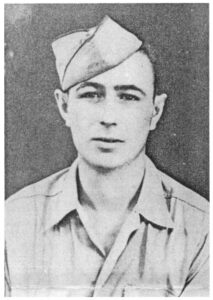
(Fr. Bartholomew Adler, chaplain of the 40th Group, was on the line immediately after the explosion. His account (written 1982): “Cpl. Aloysius M. Schumacher was quite a man. Later that dreadful Sunday afternoon I found him at the Base Hospital, clutching his stomach where he had been struck by shrapnel, telling the medics to take care of another buddy of his, Pvt. Edwin Elefant, whom he considered was more seriously wounded than he. Pvt. Elefant died later that night. Cpl. Schumacher died the next day.” [Actually, 1/22/45])
28th Air Service Group
Pvt. Paul W. Heard
Cpl. Charles C. Fulton
Though Pvt. Elefant (32785359) survived the initial explosion, he died of injuries the evening of the 14th, two days before his 21st birthday. The son of Nathan (12/25/88-10/21/67) and Anna (4/8/99-2/14/82) Elefant, his family resided at 1516 Carroll St., in Brooklyn. Born on January 16, 1924, he is buried at Mount Hebron Cemetery, in Flushing, N.Y. (Block 4, Reference 1, Section A-C, Line 11L, Grave 3). His name can be found on page 302 of American Jews in World War II.
Among the wounded survivors of the explosion was Staff Sergeant Morris Backer (11050380), who received the Soldier’s Medal, among the nine men awarded for their actions that day. His citation reads: “When a bomb explosion occurred in the aircraft on which he was working, [42-24582] S/Sgt. Backer, with no thought for his personal safety, immediately attempted to rescue those who had been seriously injured. He was successful in removing a seriously injured man who was lying alongside the rear bomb bay, where the explosion took place. He removed the injured man beyond the tail of the aircraft and remained with him until a stretcher bearer arrived and helped carry him to an adjacent ambulance. During this time a series of explosions of gas tanks, bombs and ammunition occurred and S/Sgt. Backer was wounded in the left thigh.”
The only son of Jacob (1888-5/6/59) and Ida (1890-10/18/45) Backer (his sisters were Anne, Celia, Pauline, and Tilly) of 141 Homestead Street, Roxbury, Massachusetts, Sgt. Backer was born in that state on December 28, 1919. He passed away on May 4, 2011, and is buried at the Independent Pride of Boston Cemetery, in West Roxbury. His name is absent from American Jews in World War II.
____________________
1 Lt. Jack Robert Ehrenberg
20th Air Force, 497th Bomb Group, 869th Bomb Squadron
This image of the 869th Bomb Squadron insignia was found at Pinterest.
Several (many?!) of my posts include information about airmen who served as crew members of the Boeing B-29 Superfortress very heavy bomber, typically in the case of men who were lost of combat missions.
However, among these men are a tiny few who survived the loss of their aircraft, whether as POWs of the Japanese (2 Lt. Irving S. Newman), or, over the vast expanses of the Pacific Ocean, the latter by parachuting from mortally damaged aircraft (such as F/O Aldywn W. Fields), or, after their bombers were ditched (such as Capt. Bertram G. Lynch). Another man who survived the ditching of his B-29 was Jack Ehrenberg, a crew member of the B-29 Pacific Union. Of the eleven men aboard this aircraft, only four survived; of the four, one man was captured on a subsequent combat mission, and murdered while a prisoner of war, less than one month before the war’s end.
A navigator, 1 Lt. Jack Robert Ehrenberg (0-793992) and his crew were members of the 869th Bomb Squadron of the 497th Bomb Group. His wife was Norma Constance (Loeb) Ehrenberg, who resided at 250 Passaic Ave., in Passaic, New Jersey. Jack’s parents were Michael (1886-?) and Anna (Saltz) (9/20/87-1976) Ehrenberg, at 462 Brook Ave.; also Passaic. Born in a place called Brooklyn on November 30, 1917, Jack passed away on May 12, 2005. Listed on page 231 of American Jews in World War II, he was awarded the Distinguished Flying Cross, Air Medal with three Oak Leaf Clusters (suggesting that he completed between 15 and 20 combat missions), and, Purple Heart. His name also appeared in War Department news releases on September 10, 1943, and March 22, 1945.
The incident in question – the loss of Pacific Union (42-24595, “A square 2”) – is covered in Missing Air Crew Report 11221, which, like some other MACRs pertaining to B-29 ditchings (at least, those of the 73rd Bomb Wing) and eventuated in the survival and rescue of crew members, incorporates a detailed report about the events behind and circumstances of the plane’s ditching, the escape of survivors from the plane, aspects of their survival and rescue, their suggestions for other crews faced with such situations in the future, and, comments and criticisms specifically pertaining to the loss of their plane, and, their crew’s actions. The report concludes with a really (really!) lengthy distribution list.
____________________
Before 42-24595 became the Pacific Union – notice the absence of nose art in this image? – the aircraft was photographed while flying near Mount Fuji, in the company of other 497th Bomb Group B-29s. This photo is from the 869th Bomb Squadron Scrapbook, via the 497th Bomb Group B-29 Memorial website, which contains histories of all 869th BS B-29s. There, the image appears on page 35, where it’s appropriately titled “A-2 Over Fujiyama”.
____________________
This image of December 5, 1944, showing the Pacific Union’s nose art, is from WorldWarPhotos.
____________________
What happened?
The bomber, en-route with the 497th Bomb Group to Nagoya, experienced heavy smoke of unknown origin coming from its #3 engine. When it became apparent that the aircraft couldn’t continue the mission, Captain Leonard Cox dropped out of the 497th’s formation and began a return to Saipan. After it was decided that it would be necessary to ditch the bomber, the aircraft’s bombs were toggled out individually, exploding as they struck the sea. The bomber by this time having descended to 900 feet, its wings and fuselage were struck by fragments from the bombs, and, a fire developed in the #3 engine and right wheel well. The fire could not be extinguished, and spread rapidly.
But at this point, there was insufficient time for the crew to prepare for ditching.
All emergency exits were jettisoned from the front crew compartment, and, the men in that section of the fuselage braced themselves for the impending impact with the sea – some as best they could; some not well enough. Lt. Erenberg remained at his crew position, and leaning over his desk, padded his abdomen with his parachute, at the same time giving the plane’s course, position, and ground speed to the radio operator, though he never knew if this information was actually transmitted. The men in the rear fuselage received no communication concerning the planned ditching and so were not braced properly for impact. In any event, they were forced to crowd against the port side of the fuselage, since the starboard side was too hot as a result of the fire, with the right gunner’s sighting blister becoming enveloped in flames, and flames also present in the rear unpressurized section of the fuselage.
The aircraft struck the sea at an estimated speed of 140 mph, impacting tail first. Afterwards, Lt. Erenberg stated that he believed an explosion occurred in the mid-wing section at about the moment Pacific Union hit the water. He then lost consciousness and – subsequently unaware of how he actually escaped – had no memory of any event until he found himself floating in the sea, still strapped to his seat.
These three Oogle Maps show the approximate location of the Pacific Union’s Central Pacific ditching (17-58 N, 144-03E) at successively larger scales. The Northern Marianas were approximately 216 miles to the southeast, while Agrihan Island (unlabeled, best visible in the lowermost map) is about 108 miles to the east. Very much water, very little land.
Moving closer…
…and closer.
After the bomber’s motion stopped, it was realized that the ditched aircraft had broken in two, and what remained of the front fuselage was engulfed in flames. The four crewmen in the rear fuselage exited through the escape hatch in what remained of the rear unpressurized section, bringing with them two one-man life rafts. This action was both miraculous and very smartly planned, for the bomber’s two multi-place life rafts (stored in compartments in the upper section of the mid-fuselage), with full provisions and survival gear, were lost or destroyed in the ditching.
All survivors were burned as they swam away from the wreckage, with S/Sgt. George E. Wright and Lt. Erenberg suffering multiple lacerations, and the Lieutenant also having multiple fractures in both hands. The radar operator, S/Sgt. William W. Roberts, also escaped from the tail section, but was seen only once and could not be rescued in time. S/Sgt. William P. Stovall (probably the least severely injured, based on his 1996 obituary) secured the two one-man life rafts, placing Sgt. Lawrence W. Beecroft in one and S/Sgt. Wright in another, eventually – with very great difficulty – lashing the two rafts together. Though the MACR is ambiguous on this point, it seems (?) that S/Sgt. Stovall and the other crewmen somehow placed Lt. Erenberg in (or upon?) the two rafts, with Stovall and Beecroft administering first aid as best they could to the navigator and right gunner, with the limited medical supplies on hand.
The two rafts were first spotted by Lt. Colonel Douglas C. Northrop (killed in action April 27, 1945, upon bailing out over Agrihan Island), Squadron Commander of the 877th Bomb Squadron, who circled the rafts until the arrival of a “Dumbo” air-sea rescue B-17G. The Dumbo dropped a raft and emergency equipment, but the raft was faulty and could not be inflated (? – !) and as a result, the survivors couldn’t retrieve most of the survival gear. Nevertheless, the Dumbo circled the men until about 1830K, when a destroyer arrived and rescued the four men. They had been in the water for over twelve hours.
Further information about the loss of Pacific Union can be found in the essay The Ditching of Lt. McGregor’s B-29 Crew – 23 January 1945, where it’s stated, “… Capt. L.L. Cox and crew of A Square 2, 869 Squadron had to abort the mission less than an hour out of Saipan, due to a malfunctioning engine. As Cox left the loose formation to return to base, he dropped down about 300 feet and salvoed his bombs. It was established later that the bombardier had apparently pulled the pins on the bombs before takeoff; consequently they went off when they hit the water. Since Cox’s ship was directly above the explosions, the bomb blasts caused the aircraft to crash. All but 4 members were killed and when those four were rescued, two were so badly injured and burned that they were returned to the U.S. immediately. This incident was included as part of the 73rd Bomb Wing debriefing after that mission, and directive was published warning all bombardiers not to pull the pins on the bombs until an altitude of at least 5000 feet had been reached.”
Notably, the MACR gives the B-29s altitude at the moment when it was struck by fragments from its own bombs as 900 feet, versus 300 feet in McGregor’s account. Similarly, the MACR doesn’t make any reference to the bombs having been armed prior to being jettisoned. The crewmen returned to the United States for medical treatment were Jack Ehrenberg and almost certainly George E. Wright.
You can download and read a verbatim transcript of the report about the crew’s ditching here.
A photo of the Cox crew can be found at the FindAGrave biographical profile of William P. Stovall, one of the Pacific Union’s four survivors. The image was uploaded by Sam Pennartz, who has contributed much biographical information about veterans and military casualties to FindAGrave, and, the National WW II Memorial. The men’s names are listed below the photo.
Rear, left to right
1 Airplane Commander: Cox, Leonard Leronza, Capt., 0-422385, Duncan, Ok.
2 Unknown
3 Co-Pilot: Donham, Charles Comer, Jr., 2 Lt., 0-683665, Houston, Tx.
4 Navigator: Ehrenberg, Jack R., 1 Lt., 0-793992, Passaic, N.J. – Survived
5 Flight Engineer: Contos, Charles C., 2 Lt., 0-868100, Chicago, Il.
Front, left to right
1 Gunner (CFC): Crane, Frank Joseph, S/Sgt., 16007692, Oshkosh, Wi.
2 Gunner (RBG): Beecroft, Lawrence William, Sgt., 32069587, Newark, N.J. – Survived [Shot down and captured 6/1/45; Murdered 7/21/45]
3 Gunner (LBG): (Wright, George E., S/Sgt., 38043673) – Survived
4 Radio Operator: Griffith, Melvin L., S/Sgt., 15342793, University City, Mo.
5 Radar Operator: Roberts, Willard Wayne, S/Sgt., 37245181, Kirksville, Mo.
6 Gunner (Tail): Stovall, William Peter, S/Sgt., 6563342, Kansas City, Mo. – Survived
Here’s the same photo, as printed in a halftone format in The Long Haul: The Story of the 497th Bomb Group (VH). Like all crew photos in that book, the only text associated with the image is the crew commander’s name, all other crewmen being anonymous. Then again, even the identity of the crew commander (front row? back row? far left? kneeling? far right?) isn’t actually specified for any image.
Prior to being assigned to the 497th Bomb Group, Captain Cox was a First Lieutenant in the 324th Bomb Squadron of the 91st Bomb Group (8th Air Force), in which he piloted B-17F 42-29921, Oklahoma Okie. The picture showing Lt. Cox and Okie is Army Air Force photograph 79288AC / A12688, and was taken at Bassingbourne, England, on June 16, 1943.
William P. Stovall, born in 1918, died in 1996 at the age of 77. According to his obituary in The Independent-Record (of Helena, Montana) of March 3 1996, he was the only crew member of the Pacific Union who was uninjured in the plane’s ditching; he ultimately completed approximately 25 missions.
Sgt. Beecroft was infinitely less fortunate. Eventually having recovered from his injuries, he resumed combat flying. Almost six months later, he was shot down during the Osaka mission of June 1, 1945, while flying in the crew of 1 Lt. Franklin W. Crowe aboard B-29 42-65348 (A square 16). Seven of the plane’s eleven crew members were killed in the bomber’s crash (at the foot of Mount Sanjogadake, in the Omine Mountains, Tenkawa-mura, Yoshino-gun, Nara-ken), and four were captured. The latter were Sgt. Beecroft, Central Fire Control Gunner M/Sgt. Alvin R. Hart, Bombardier 1 Lt. Harrison K. Wittee, and Radar Operator S/Sgt. Russell W. Strong. As immediately evident from biographical information at FindAGrave, as well as Doug’s extensive research and documentation concerning the 497th Bomb Group, and, 73rd Bomb Wing aviators who were captured by the Japanese, none of the four survived: They were murdered before the war’s end.
Though not the immediate subject of this post, the awful fate of those four survivors of A square 16 pertains to the larger topic of the fate of Allied POWs of the Japanese in general, and the that of Allied aviators in Japanese captivity, in particular. There’s an enormous (perhaps incalculably large?) body of historical information and literature on this topic, in print, on the Internet, in historical repositories such as the United States National Archives, and certainly in unpublished format among the personal records and memorabilia of the descendants of WW II servicemen. Suffice to say that while several hundred Allied aviator POWs did survive Japanese captivity, a very significant proportion of men who were initially captured and could have survived, did not.
This portrait of Sgt. Beecroft – as a Corporal – is by FindAGrave contributor William Duffy.
Lieutenant (JG) Milton Harold Thuna
United States Navy, Patrol Bomber Squadron VPB-110
Paralleling the loss of Captain Fineman and Private Elefant in incidents unrelated to enemy activity, Navy Lieutenant (JG) Milton Harold Thuna (0-145553), a co-pilot, was killed in yet another non-combat aviation accident. The incident involved a PB4Y-1 Liberator (Bureau Number 63944) of Patrol Bomber Squadron 110 (VPB-110) in North Africa.
This image (via pinterest) is a very good representative view of a PB4Y-1.
As described at VPNavy.com (from on November 22, 2001) the aircraft , “…took off from Marrakech, French Morocco, on a ferry flight to Dakar, Senegal. No radio contact was made by plane after leaving vicinity of Marrakech Airport. At about 0900 GMT, Arab natives saw the plane break through the overcast at 2000 ft, in a shallow normal glide in vicinity of Tazmint, French Morocco. Witnesses reported the engines were not functioning properly. Shortly after becoming visible, the plane was seen to catch fire and explode, detaching pieces of the aircraft. It was seen to go out of control immediately following the explosion. Examination of the wreckage at the scene of the crash showed that the portion of the port wing outboard of the aileron became detached in the air, landing three-hundred yards from the main body of the wreck. It was also found that the plane’s rudders and vertical tail surfaces became detached in the air, being found in an area approximately three-hundred yards from the main body of the wreck.”
Besides Lt. Thuna, the bomber’s crew comprised:
Pilot: Lt Ralph David Spalding, Jr.
Ensign Milo Junior Jones
AOM 2C James Thomas Hagedorn
ARM 2C Norman H. Lowrey
ARM 1C F.W. Riffe
AOM 3C Robert W. Baker
AMMF 3C Frank Andrew Lutz
AMM 2C Milford Dewitt Merritt
ARM 3C E.M. Lingar
AOM(T) 3C William E. Burns
Born in Brooklyn, New York on March 22, 1918, Lt. Thuna was the son of Helena Mendelsohn (11/9/88-11/13/74), who resided a 106-24 97th Street in Ozone Park. The origin of his surname is unknown. Perhaps it was that of his father, who I’ve thus far been unable to identify. The lieutenant is buried with six of his fellow crew members at Arlington National Cemetery, in Grave 16, Section 15.
News articles about Lt. Thuna appeared in The Leader-Observer on 5/21/42, 3/11/43, 3/25/43, The New York Sun on 2/19/45, and The Record 2/22/45, while his name can be found on page 461 of American Jews in World War II.
____________________
Soviet Union / U.S.S.R. (C.C.C.Р.)
Red Army [РККА (Рабоче-крестьянская Красная армия)]
Bargman, Solomon Semenovich (Баргман, Соломон Семенович), Guards Junior Lieutenant (Гвардии Младший Лейтенант)
Machine Gun Platoon Commander (Командир Пулеметного Взвода)
16th Guards Mechanized Brigade
Born 1924
Killed in Action
Gofman, Aleksandr Volfovich (Гофман, Александр Вольфович), Sergeant (Сержант)
Armor (Radio Operator – Gunner) (Радист-Пулеметчик) – T-34
68th Tank Brigade
Born 1924, city of Korets, Rovenskiy Raion
Killed in Action
Buried in Poland
Kofman, Shalim Shavelevich (Кофман, Шальим Шавельевич), Lieutenant (Лейтенант)
Rifle Company Commander (Командир Стрелковой Роты)
449th Rifle Regiment, 144th Rifle Division
Killed in Action
Born 1909
Layzer, Peresh Yakovlevich (Лайзер, Переш Яковлевич), Private (Рядовой)
Armor (Miner) (Минер)
32nd Tank Brigade
Born 1914, Struzhenskiy Raion
Died of wounds (умер от ран) at Mobile Surgical Field Hospital 492 (Хирурический Полевой Подвижной Госпиталь 492)
Buried in Hungary
Lev, Naum Aronovich (Лев, Наум Аронович), Captain (Капитан)
Chief, 1st Headquarters Staff (Начальник 1 Отделения Штаба)
5th Mountain Rifle Brigade
Born 1918
Killed in Action
Matskin, Volf Abramovich (Мацкин, Вольф Абрамович) Senior Lieutenant (Старший Лейтенант)
Rifle Platoon Commander (Командир Стрелкового Взвода)
314th Rifle Regiment, 46th Rifle Division
Born 1912
Killed in Action
Mikheylis, Yooriy Aleksandrovich (Михейлис, Юрий Александрович), Senior Lieutenant (Старший Лейтенант)
Machine Gun Company Commander (Командир Роты Автоматчиков)
216th Guards Rifle Regiment, 79th Guards Rifle Division
Killed in Action
Born 1924
Nirkis, Meer Ayzikovich (Ниркис, Меер Айзикович) Lieutenant (Лейтенант)
Rifle Platoon Commander (Командир Стрелкового Взвода)
1210th Rifle Regiment, 362nd Rifle Division
Born 1916
Killed in Action
Presman, Semen Alekseevich (Пресман, Семен Алексеевич) Junior Lieutenant (Младший Лейтенант)
Rifle Platoon Commander (Командир Стрелкового Взвода)
717th Rifle Regiment, 170th Rifle Division
Born 1922
Killed in Action
Segelman, Moisey Abramovich (Сегельман, Моисей Абрамович), Guards Major (Гвардии Майор)
Deputy Chief of Staff, also, Chief of Headquarters Operational Intelligence
(Заместитель Начальника Штаба он-же Начальник Оперативного Разведывательного Отдела Штаба)
2nd Guards Motorized Assault Engineer-Sapper Brigade
Born 1917, city of Tomsk
Killed in Action
Buried in Lithuania
Shlafman, Girgoriy Khaskelevich (Шлафман, Григорий Хаскелевич), Guards Lieutenant (Гвардии Лейтенант)
Machine Gun Platoon Commander (Командир Пулеметного Взвода)
265th Guards Rifle Regiment, 86th Guards Rifle Division
Killed in Action
Born 1924
Shmidberg, Arkadiy Nikolaevich (Шмидберг, Аркадий Николаевич), Guards Senior Sergeant (Гвардии Старший Сержант)
Armor (Gun Charger) (Заряжающий) – T-34
213th Autonomous Tank Brigade
Born 1910, city of Tulya
Killed in Action
Buried in East Prussia
Slutsker, Abram Lazarevich (Слуцкер, Абрам Лазаревич), Lieutenant (Лейтенант)
Machine Gun Platoon Commander (Командир Пулеметного Взвода)
187th Guards Rifle Regiment, 47th Guards Rifle Division
Died of Wounds
Born 1925
Tsap, Abram Lvovich (Цап, Абрам Львович), Captain (Капитан)
Political Agitator (Агитатор)
216th Guards Rifle Regiment, 79th Guards Rifle Division, 8th Guards Army
Killed in Action
Born 1902
Vanshteyn / Vaynshteyn, Veniamin Abramovich (Ванштейн/ Вайнштейн, Вениамин Абрамович), Lieutenant (Лейтенант)
Rifle Platoon Commander (Командир Стрелкового Взвода)
291st Rifle Regiment, 63rd Rifle Division
Born 1904
Killed in Action
Yakuboshvili, Lev Mototeevich (Якубошвили, Лев Мототеевич), Senior Sergeant (Старший Сержант)
Armor (Gun Commander) (Командир Орудия) – T-34
213th Autonomous Tank Brigade
Born 1925, city of Baku
Killed in Action
Buried in East Prussia
____________________
Canada
Flight Officer Joseph Klatman
Royal Canadian Air Force, Number 1666 Heavy Conversion Unit
Flight Officer Joseph Klatman (J/39890), a navigator serving in No. 1666 Heavy Conversion Unit, Royal Air Force, was lost with his six fellow crewmen (all members of the RCAF) when their bomber, Lancaster I HK756, piloted by eighteen year old Flight Officer Victor Robert Adams, vanished during a “Sweepstake” mission on the evening of January 14-15, 1945. As described on page 156 of W.R. Chorley’s Bomber Command Losses (covering Heavy Conversion Units, and, Miscellaneous Units), the aircraft, took off, “…from Wombleton as part of a force of one hundred and twenty-six aircraft, drawn from the training units, ordered to sweep across the North Sea in the hope of luring the Luftwaffe into the air. Lost without trace.”
This document, from F/O Klatman’s Service File, found in “World War II Records and Service Files of War Dead (Canada), 1939-1947”, at Ancestry.com (not a plug; just stating the source), dated September 30, 1947, summarizes the extent of information available concerning the loss of Lancaster HK756: In effect and reality, none … whether in 1947 or 2023.
Bomber Command Losses notes that, “…F/O Adams RCAF was amongst the youngest bomber pilots to lose his life in the Second World War.” His RCAF Service File reveals that he was born in England on May 23, 1925.
Akin to all crew members of HK756, a letter verifying their son’s missing in action status was sent to F/O Klatman’s next of kin – in this case, his parents – by Squadron Leader Lewington at RCAF Station Wombleton. (Spelling uncertain.)
Born in Blati, Romania, on August 13, 1923, Joseph was the son of Samuel (1892-9/8/70) and Tuba “Toby” (Tipleatsky / Teplitzky) (1895-5/8/33) Klatman, and brother of Pearl, the family residing at 23 Brunswick Ave. in Toronto, Ontario. His civilian occupation prior to entering the RCAF was “shipper”.
These two photographic portraits of F/O Klatman are also present in his Service File. A review of Service Files shows that such images are typically – but not always! – found in Service Files for aviators, but rarely in Files for non-commissioned officers.
The upper photo was taken on February 17, 1943, but the lower photo is undated.
F/O Klatman’s name is commemorated on Panel 279 of the Runnymede Memorial, in Surrey, England, while his biography is found on page 40 of Part II of Canadian Jews in World War Two.
On the ground…
Private Leo Smith (Shomomenko)
Loyal Edmonton Regiment
Born in Gomel, Belarus, on September 21, 1918; a cleaner and presser in civilian life, Private Leo Smith (original surname Shomomenko), M/11468, died of wounds in Italy while serving in the Loyal Edmonton Regiment. He and his wife, Columba Gallina Smith (7/20/18-9/09), resided at 1117-5th Ave., in Calgary, Alberta, with their daughter Sylvia Susan, who was born on January 28, 1940. His parents were Abraham (12/10/98-5/8/91) and Rose (Kagansky) (7/17/99-9/21/82) Smith, his brother Allan, and his sisters Mary Gofsky and Pauline (a.k.a. “Polly”).
Pvt. Smith is buried at the Argenta Gap War Cemetery, at Ferrara, Italy (IV,E,12). His very brief biography appears on page 73 of Part II of Canadian Jews in World War Two.
Private Smith’s biographical profile at FindAGrave.com includes a transcript of a news article from The Calgary Herald of January 25, 1945, which concludes upon the statement, “A short time ago, Pte. Smith had cabled home that he was due to receive leave and expected to be home for the first time in nearly five years,” paralleling Canadian Jews in World War Two, which states, “A veteran of four and one-half years overseas, he was killed a few days before he was scheduled to return home on leave.” Neither the newspaper article nor Canadian Jews in World War Two could have elaborated upon the impetus for Pvt. Smith’s anticipated return to Canada, for this information was unknown to the public. However, with the passage of time, the advent of the internet, and the accessibility of World War II Records and Service Files of Canadian War Dead at Ancestry.com, more – much more, about a family during wartime – is revealed.
It turns out that Private Smith requested leave to visit his family, the result of a letter from his sister Polly of November 7, 1944. The original letter – probably having been returned to Pvt. Smith – is absent from the File, a verbatim transcript taking its place. Therein, Polly succinctly, frankly, and compellingly describes the effects of Leo’s absence upon his mother, daughter, and wife, notably (this is as revealing as it’s unsurprising, given the passage of almost five years of military service) intimating that her brother’s long absence had affected his marriage to Columba, suggesting that their marriage may have been under strain prior to his enlistment in the army. The letter is persuasive, poignant (very poignant), and powerful, and seems to have been compelling enough for the Canadian military to grant leave to Private Smith.
In a war of innumerable tragedies and countless ironies (but is that not so of all wars?), his return to his wife and family – to have taken place in early in 1945 – would never happen.
Time has passed. Private Smith’s parents, Abraham and Rose, passed away in 1991 and 1982, respectively; his wife Columba Smith in 2009. His daughter Sylvia Susan, four years old when her aunt Polly composed the letter to her father, would now in the year 2023 be eighty-three years old.
Here’s an image of the letter, from his Service File, followed by a transcript:
Nov 7/44
1610 – Scotland St.
Calgary
Dear Leo:
We received your air-mail letter to-day and I was sure happy to hear from you.
Leo dear, you must come home, there’s so much you must know. Mother is very ill and many a morning she can’t get out of bed. The doctor’s in the city don’t know what is wrong with her. She has been to every doctor and there is no cure, so we do not know how long she will hold out. The only thing she wants now is to see you home again and if you were to try to come home, she would have something to live for. But now she has nothing. She says for you to try to come home as soon as you can.
Sylvia does not quit talking about you every day and is waiting for the day her daddy is coming home. Edna’s husband is coming home this week and Betty Anne doesn’t quit talking about him and Sylvia wants to know when her daddy is coming home.
It is true of course that Columba has gone through very much but the only thing stopping her from telling you to come back is her pride. But she’s told me she still loves you. Leo, you just have to come back home and as soon as possible. Mother won’t last much longer if she hasn’t get to see you soon. For Mother’s and Dad’s and Sylvia’s sake you must come home. Leo dear, please try your hardest.
You may think these are big words for a little girl but I’m more grown up than Mary.
I am leaving for New York to the University June the end of June and hope to see you before I leave because I hardly know you. Please try to come home soon as I can’t stand seeing Mother going to pieces.
Love,
Polly
Mother sends all her love to you
Certified this is a true copy of a letter
dated 7 Nov 44 received by the petitioner
from his sister, Polly, 1610 Scotland St.,
Calgary Alta.
(R.R. Brown) Capt
Legal Officer
4 Cdn Rft Bn 1 CBRG
____________________
____________________
References
Books
Burkett, Prentice “Mick”, The Unofficial History of the 499th Bomb Group (VH), Historical Aviation Album, Temple City, Ca., 1981
Chorley, W.R., Royal Air Force Bomber Command Losses – Heavy Conversion Units and Miscellaneous Units, 1939-1947 (Volume 8), Midland Publishing, Hinckley, England, 2003
Dublin, Louis I., and Kohs, Samuel C., American Jews in World War II – The Story of 550,000 Fighters for Freedom, The Dial Press, New York, N.Y., 1947
Lundy, Will, 44th Bomb Group Roll of Honor and Casualties, 1987, 2004 (via Green Harbor Publications)
Mireles, Anthony J., Fatal Army Air Forces Aviation Accidents in the United States, 1941-1945 – Volume 3: August 1944 – December 1945, McFarland & Company Inc., Publishers, Jefferson, N.C., 2006
Morris, Henry, Edited by Gerald Smith, We Will Remember Them – A Record of the Jews Who Died in the Armed Forces of the Crown 1939 – 1945, Brassey’s, United Kingdom, London, 1989
Swanborough, Gordon, and Bowers, Peter M., United States Navy Aircraft Since 1911, Funk & Wagnals, New York, N.Y., 1968
Canadian Jews in World War II – Part II: Casualties, Canadian Jewish Congress, Montreal, Quebec, Canada, 1948
The Long Haul : The Story of the 497th Bomb Group (VH), Newsfoto Pub. Co., San Angelo, Tx., 1947
40th Bombardment Group: A pictorial record of events, places, and people in India, China and Tinian from April 1944 through October 1945. Included are a few aerial views of Nippon, Singapore, Formosa and other exotic, far-off places, Newsfoto Pub. Co., San Angelo, Tx., 1945 (via Bangor Public Library)
Acknowledgment
Special thanks to Ari Dale for her translation of the inscription on Captain Sanford S. Fineman’s matzeva: “Thanks, Ari!”
Websites
The B-26 Marauder in US Navy and Marine Corps Service, at B26.com
May 13, 2017 459



